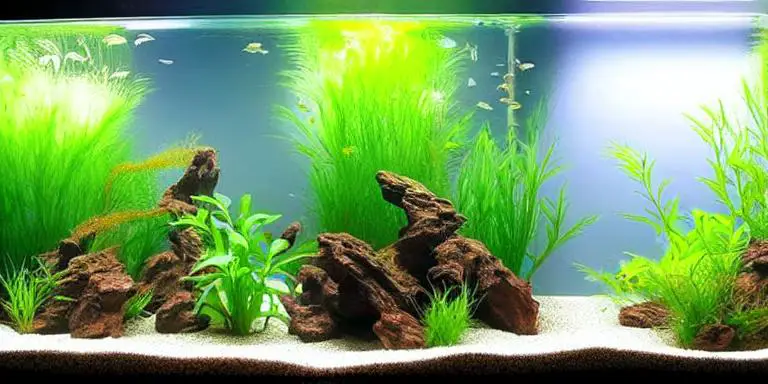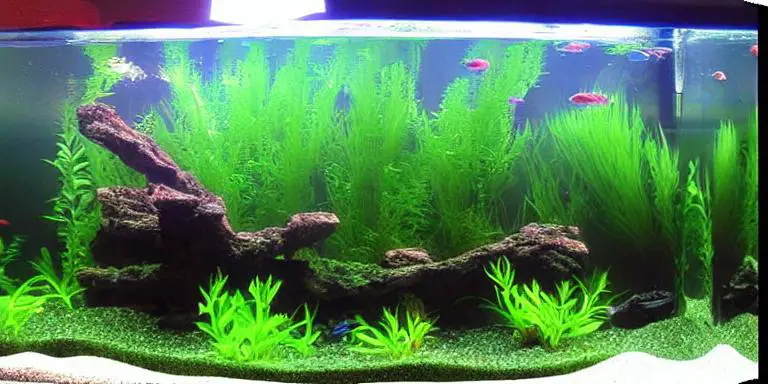Getting rid of fish tank mold is not a challenging task if you know how. With a few simple tips, you will be on your way to a fresh and healthy-looking tank in no time.
Symptoms of Fish Tank Mold
Symptoms of fish tank mold include a black fuzzy texture. It is also susceptible to light, and this can spread quickly when it is in the water. It is detrimental not only to the fish but also to other living creatures.
You can prevent it by replacing the water in your tank every week, and this is a simple step to do and helps maintain the oxygen levels in your aquarium.
It would be best if you also cleaned your siphon inside your tank, which should be clean and free of phosphates. If you have an older siphon, you may want to replace it with a new one.
If you have a large fish tank, you should consider having a professional take care of the problem. This is because a large mold infestation can be costly to remove.

Another good way to keep your fish healthy is to provide them with food and water-rich nutrients. Aside from fish, you may also want to add live plants to your tank, and these plants help improve the water quality and your tank’s overall appearance.
If you are experiencing symptoms of fish tank mold, the best thing to do is to keep your tank clean and avoid direct sunlight, this will prevent mold from growing. You can also use chemical-free natural tissue paper to wipe the gunk off your tank’s surfaces.
Getting Rid of Fish Tank Mold
Mold can form on various parts of the aquarium, and it takes different approaches to remove it depending on the location of the mold.
Getting Rid of Fish Tank Mold from Your Lid
- Take off your fish tank lid and spray the mold with Hirogen peroxide.
- Let it sit for a few minutes.
- Use a sponge to wipe the mold off the lid; it will come loose now.
- Spray the area of the lid one more time with Hirogen peroxide.
- Rinse the lid with water and put it back on the tank.
Getting Rid of Fish Tank Mold From Your Plants
- Take your plants out of the aquarium.
- Place the plants in a mild solution of chlorine. Let the plants soak for a few minutes.
- Rinse the plants in clean water to eliminate excess chlorine and remove the mold using your fingers.
- Now you can put the clean plant back in the aquarium.
Instead of using chlorine/bleach, you can also use Hydrogen peroxide.
Getting Rid of Fish Tank Mold From Your Gravel and Hardscape
- Remove the hardscape and/or gravel from your aquarium.
- Place it in a colander in the sink. Soak the gravel in mild chlorine and water, killing mold and (unfortunately, the beneficial bacteria).
- Leave it for a few minutes.
- You can scrub down the hardscape with an old toothbrush.
- Rinse the gravel and hardscape with clean water for a few minutes to remove the loose mold particles and all traces of chlorine.
- Place the gravel and/or hardscape in your aquarium.
Getting Rid of Fish Tank Mold From Your Glass
- Use an algae scraper to scrape away all the mold in a fish tank.
- Do a water change to get rid of the floating mold pieces.
Alternatively
- lower the aquarium’s water level until the mold is exposed to the air.
- Now spray the mold with Hydrogen peroxide.
- After a few minutes, wipe off the dead mold with a clean cloth or a paper towel.
Causes of Fish Tank Mold
Having mold in your aquarium can be harmful to your fish, and it can cause several different ailments. These ailments include fish tank allergies, fish tank infections, and fish tank syndromes.
Mold in aquariums comes in several different varieties. It’s best to know what to do if you find mold in your aquarium.
Water mold is a type of fungus that you can commonly find in stagnant waters, and it’s composed of branched filaments and a tube-like vegetative body, mycelia. Typically, water mold doesn’t attack healthy fish; however, it can cause infections and other problems if left untreated.
Water mold can be caused by excess food, dirty water, and contaminated fish food, and it can also come in through new fish or live plants.
The first step in fighting mold in your fish tank is to remove any infected food. You can remove mold in your fish tank by removing 50% of the water in your tank, and changing the water in your aquarium at least twice a month is essential.
Clean your aquarium with a dechlorinator and water clarifier. Use a glass scraper or toothbrush to get in the corners of your tank. Rinse your tools thoroughly with vinegar.
Once you’ve removed the mold, rinse your tank. Then, replace the water in your tank. It would be best if you replaced your filter cartridge, and it would be best if you also kept a separate container of clean water, and it’s best to store this water in a separate room from the tank.
Adding an air pump can help increase water movement, loosening mold particles.
Another way to prevent mold in your fish tank is to use antifungals. Antifungals will not only remove fungi, but they will also keep the water clean.
Prevention of Fish Tank Mold
Keeping your fish tank clean and disinfected can prevent mold from forming in the first place. Mold can be hazardous for your fish and you, and it can cause secondary diseases and can even be fatal.
Mold is a very natural part of the aquatic world. It can occur on anything wet in the tank, and it may also appear on the inside of the tank lid. If you notice a fuzzy film inside your lid, it could mean that you have airborne mold. This mold is most common in fish tanks located in direct sunlight.
The best way to prevent mold in your fish tank is to replace the water regularly. You can either siphon the water into a bucket or use an electrical siphon to remove it, and you should change it at least once a month.

Getting rid of fish tank mold can be very difficult. Mold in the water can cause several health problems to the fish, which is why it is crucial to clean the tank regularly. Performing a water change is also an excellent way to prevent mold growth.
Mold in the water is most common in fish tanks that are near the sun, and this is because the fungus is sensitive to sunlight and starts to grow in the corners of the tank that receive the most direct sunlight.
Mold in the water also grows on dead fish and plants. It is crucial to remove the fish from the aquarium if you notice this type of mold.
Once the aquarium is clean, you should transfer the fish to a new tank, which you should do at least once a month. The fish should be replanted in the new tank and transferred to filtered water.
Mold in the water can also be caused by temperature variations, and these fluctuations can lower the pH levels of the water. Keep the temperature of the water at a level of 68 to 74 degrees Fahrenheit.
Excess food particles in the water can also cause mold. Your aquatic animals eat these particles, and the fungus may also infect them. This is why removing dead fish and food from the tank is essential.
Mold in the water is also caused by phosphates. It is essential to use water clarifiers and dechlorinators to ensure the water is clean.
Using a separate container of clean water for your aquarium is also essential, and the container should be kept in a different room from the tank. This way, you can easily clean your tank without introducing mold.
